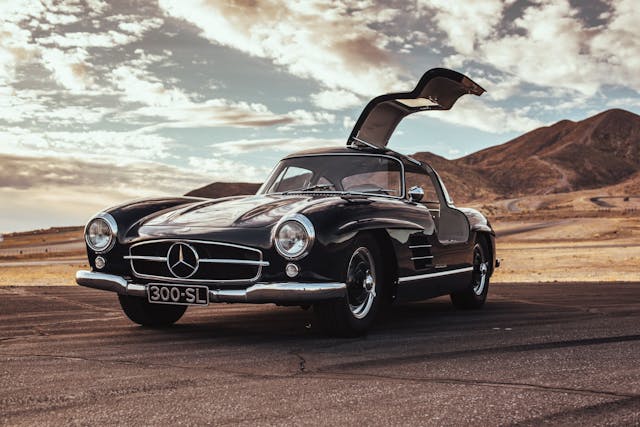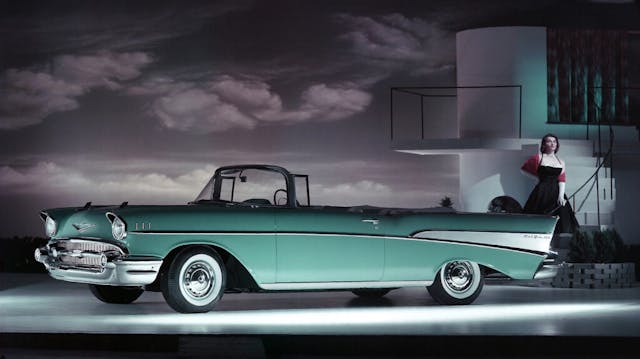Old School Mechanical Fuel Injection Juices These Cars’ Values
As the new enthusiast vehicle market moves increasingly towards hybrid systems, dual-clutch transmissions, turbochargers, and all manner of computer systems managing the power going to the ground, enthusiasts are seeking out vintage vehicles with none of those things. Vehicles with drivetrains featuring naturally aspirated engines and manual transmissions have enjoyed renewed popularity. But there is one piece of technology, often discarded when it was new, that is shared by some of today’s most collectible vehicles, and yet it doesn’t get talked about much.
For a period in the middle of the 20th century, before electronic fuel injection became the solution to performance and emission considerations, automakers added nth-degree performance to their best models via mechanical fuel injection (MFI). The excellent throttle response and additional horsepower made them ideal for enthusiasts, but the complexity of mechanical fuel injection made them expensive and difficult to repair, so owners commonly swapped them out for familiar carburetors. Today, though, despite MFI systems being a dead-end in the evolution of the automobile, they are better understood and are often more valuable than the carb versions. Indeed, they’re a feature of some of the most collectible cars ever produced.
Many manufacturers embraced mechanical fuel injection, including Aston Martin, Jaguar, Lancia, Maserati, Pontiac and Volkswagen, but below are arguably the most famous MFI classics, with pronounced premiums in value.
Mercedes-Benz 300SL

Mercedes-Benz was the first to introduce a system in their automobiles when they used a Bosch system designed for airplane engines in their new 1950s supercar, the W198-series 300SL. Mercedes-Benz was constrained by using the 3.0-liter inline 6-cylinder engine from the contemporary W186 sedan, but they sought to maximize the performance of all the other components. The frame was a lightweight spaceframe (hence the Gullwing doors), the bodywork was aerodynamic, and the engine was leaned over at 50 degrees and given a dry sump. After experimenting with supercharging and Solex carbs in the racing cars, the W198 was given the Bosch a (direct) mechanical fuel-injection system, which bumped performance from an unreliable 230hp in Solex-supercharged form (the M197 engine) to a reliable and drivable 240hp in production form (M198). Today, the 300SL is one of the few cars built in the thousands that routinely sells for over $1M. The current condition #1 (“concours”) value for a 1955 steel-bodied Gullwing coupe is $2,250,000. The high prices relative to its production number are down to the 300SL’s famous style, cultural impact and world-class performance, the latter in part made possible by adopting fuel injection technology decades before it became ubiquitous.
Porsche 911 Carrera RS 2.7

The 1973 Porsche 911 Carrera RS 2.7 wasn’t the first car Porsche equipped with a mechanical fuel-injection system (that was the 1969 911 S), but it is one of the most collectible if not the most collectible road-going Porsche. And although fuel injection wasn’t as exotic in the early 1970s as it was in the ’50s, it was still far from commonplace. As the company pivoted away from racing prototypes like the 917 and 908/3 due to rule changes, the nearly 10-year-old 911 became the chosen platform for racing. Pushing the displacement out from a stated 2.4 to 2.7 liters was possible by using a cylinder liner specially developed by Mahle (for the 917) called Nikasil, and with the MFI system, the new model had 210 HP (an increase of 20 HP over the contemporary 911 S 2.4). In heavier “Touring” spec, the 1973 Carrera RS 2.7 isn’t quite as valuable as the 300 SL (current condition #1 value of $999,000), but the Lightweight (only 200 out of the 1580 built), has a current condition #1 value of $2.1M.
Alfa Romeo Montreal

The Italians embraced mechanical fuel injection, too. The International and Universal Exposition, aka Expo 67, aka the world’s fair for 1967, took place in Montreal, Canada. With a theme of Man and His World, Alfa Romeo was invited to display a vehicle representing the ultimate evolution of the automobile. Alfa brought a concept, designed by Marcello Gandini at Bertone, and appropriately named it the Montreal. Despite its 4-cylinder Giulia Sprint GT base, Gandini gave it some mid-engine styling touches and the car impressed showgoers so much that Alfa Romeo decided to offer a production version. Bringing the Montreal to market took longer than expected, and by its launch in 1970, the intended competition was cars like the Porsche 911 described above. Consequently, Alfa got more ambitious with the engine and used a 2.6-liter V-8 inspired by its Tipo 33 racing car and equipped it with SPICA (Società Pompe Iniezione Cassani & Affinimechanical) fuel injection good for 200hp. With nearly 4000 produced, the car isn’t as rare as some of the MFI-fed classics on this list, but demand remains consistent, and the condition #1 value is currently $158,000.
BMW 2002tii

BMW had a hit on its hands with its Neue Klasse small sedans. Launched in 1961 as the 1500, it was intended to compete with the Volkswagen Beetle. Despite that humble target, sporty versions followed with models such as the 4-door 1800ti in 1965 and then the 2-door 1600ti. The ti suffix stood for Touring International, and indicated the model featured twin carbs. When that 1600ti version couldn’t meet emissions regulations in the U.S., the single-carb 2.0-liter 2002 was introduced. A two-carb 2002ti was also offered, but BMW went even sportier in 1972 with the 2002tii. Featuring a mechanical fuel-injection system by Kuglefischer, the tii (Touring International Injection) model gained 16hp over the carb 2002 for a total of 130. While all versions of the 2002 have become collectible in the past several years, and the 1972 model has a condition #1 value of $84,600 at present, the 1972 2002tii is worth significantly more and has a condition #1 value of $129,000.
1957 Chevrolet


In 1950s America, the Big Three were in a horsepower race. Bragging rights went to engines that could achieve one horsepower (gross, not net) per cubic inch (cid) of displacement. Further, GM was known for its technical innovations in the 1950s, and fuel injection seemed like the right way to give the recently launched (1955) Chevrolet small-block V-8 an edge. The result was the Rochester Products Division Ramjet mechanical (port) fuel-injection system launched for the 1957 model year cars. The 283 cubic inch Chevrolet V-8 with the Ramjet system produced 283hp, meaning it reached that magical one hp per cube threshold. Nicknamed Fuelies, the Corvettes and Bel Airs equipped with the system won the numbers race for years. They won on the racetrack, but it was also the highest-performance version of the Corvette through the 1965 model year when the 327cid V-8 Fuelie made 375hp. For the 1957 Corvette, the current condition #1 value for a Fuelie is $185,000 compared to $144,000 for the 270hp dual-quad 283 Corvette built the same year. For a 1957 Chevrolet Bel Air Sport Sedan, a 283 Fuelie has a condition #1 value of $125,000 compared to $109,000 for that same 270hp dual-quad setup.
***
Check out the Hagerty Media homepage so you don’t miss a single story, or better yet, bookmark it. To get our best stories delivered right to your inbox, subscribe to our newsletters.



Many Mercedes Benz cars made from 1958-1972 employed Bosch mechanical fuel injection.
Among them the 230/250/280 ‘Pagoda’ convertibles and the W108 ‘SE’ cars. I own/drive a
1970 280 SE sedan; the fuel system has always been reliable if properly maintained.
The challenge these days is the scarcity of technicians with experience maintaining them.
Anyone who has tried to get a SPICA equipped car to run well and longer than a few days deserves a trophy! The Lucas systems on many Maserati were pretty good and stayed in tune quite well all things being equal. Speaking of mechanical ever work on Piersberg (sp) injection…have seen it once on a BMW 6 cyl.
That junk on the Imperial was a noble idea that was short on testing as well as execution. When I worked at Mopar I saw the book once (one year only) . You would be hard to find a production Chrysler equipped with the stock system . They just wouldn’t work and have been relegated to the bin of auto history BUT it wasn’t in the least bit mechanical ….ish.
I have no issues with the SPICA on my 1974 Alfa GTV. If your SPICA needs a rebuild, Wes Ingram’s shop does a masterful job.
i agree the tr5 tr6 cars should have a mention also yhink it was the same system on masarati
I would have liked to see a front engine roadster with Hilborn fuel injection.
Gentlemen, START YOUR ENGINES!
Another early adopters of fuel injection was Maserati our 67 Mistral 4000 had its Lucas derived system. When running properly it did a respectable job unfortunately as with most Lucas components the engineering was good but its execution was poor. I eventually replaced/modifified the system with other reliable components. One of its most interesting features was the metering head which by lack of vacuum would increase fuel supply to the injectors. This would allow for superior acceleration and better performance at altitude. ( This also required fine tuning/modification to work correctly.
Following the German surrender in May 1945, parties of Western technical experts joined US military intelligence groups who thoroughly pillaged and copied the industrial research of Daimler-Benz, Junkers, Focke-Wulf,Messerschmidt, Krupp, Mauser and all other companies who had armed Hitler’s forces. Westinghouse, General Electric, GM, Ford & Chrysler were well represented and received the fuel-injection technologies as well as the design specifications for the Junkers Jumo jet engines which powered the ME-262 and other aircraft. The Junkers company had developed an altitude-compensated FI system for their V-12 aircraft engine which was not selected for production by the Luftwaffe aircraft bureau; that system which used combinations of diaphragms with pivoting levers became the GM-Rochester FI system used by Chevrolet and Pontiac. Chrysler substitued vaccuum sensors and electronic/electric tubes and injectors to make an FI system for their mid-1950s high-performance systems. All highpower automotive motors built following 1945 used the technologies of the fighter and bomber aircraft in that war; both WW1 and WW2 enormously accelerated technological development in engineering and weaponry.
The Lucas mechanical fuel injection system was use by Maserati , Ferrari , Lotus among others. Both road cars and race cars. Cutting edge at the time and eventually they developed the a PI for TR-5/6.